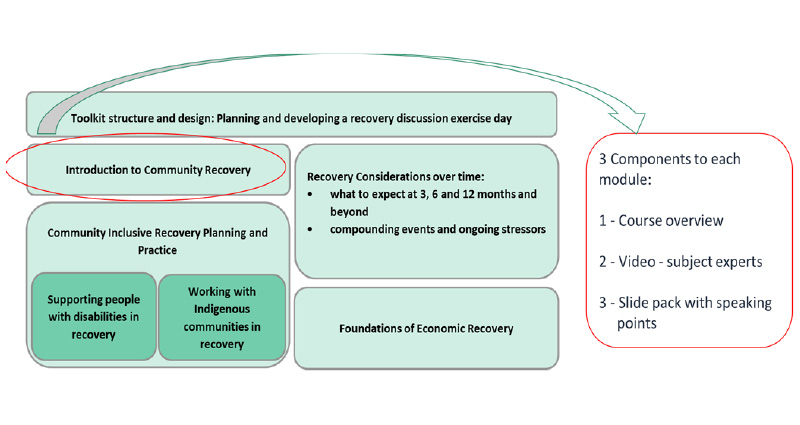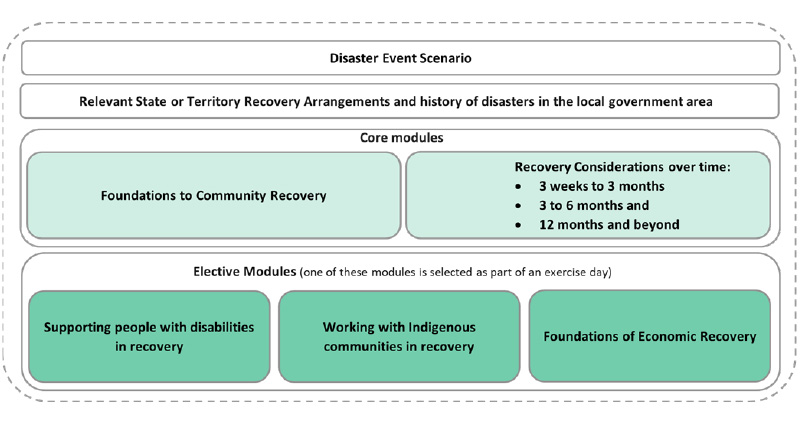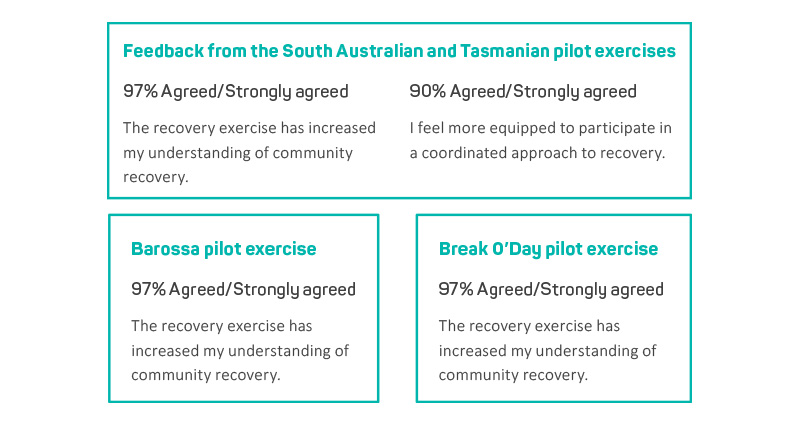In recent years, people around the world have experienced an increase in the frequency and severity of extreme events; from bushfires to floods and pandemics. In Australia, the Royal Commission into National Natural Disaster Arrangements 2020 determined that Australia increasingly faces cascading, concurrent and compounding natural hazards and that ‘stress testing’ disaster plans and evaluating outcomes will be crucial for the future.
The royal commission found that the extent and nature of recovery exercising varied across Australia’s jurisdictions, with exercising being irregularly or inconsistently undertaken in an integrated fashion or not having the capacity to develop specialised recovery exercising.
The ongoing challenges in recovery from events like the Australia’s 2019–20 summer bushfires and 2022 floods highlighted that planning and exercising for recovery is as important as planning and exercising to respond. Integrating recovery exercising into regional and local emergency management programs is critical to build holistic approaches to preparing for, responding to and recovering from extreme events.
While emergency management exercising programs are mature and well-practiced across Australia, historically, exercising has focused on arrangements for the emergency response to, and immediate relief from, an event. The recovery phase has been included as the final element in an exercise scenario, often with limited time for discussion or consideration of the complex issues. While recovery starts at the same time as the response, it is long-lasting and complex and involves a broad range of community and stakeholders.
Regional Recovery Exercising Program
The Regional Recovery Exercising Program has 2 components of:
- a Recovery Exercising Toolkit
- a pilot program of regional recovery exercises.
Recovery Exercising Toolkit
The Recovery Exercising Toolkit (Figure 1) is a national resource that supports recovery planning and capability development through exercising at the regional and local emergency management levels. It also supports emergency management committees, local councils and other groups through evidence-based guidance and a set of specialised resources to enable emergency planners to follow a pathway in a recovery discussion exercise.

Figure 1: The Recovery Exercising Tools help planners step through a standardised method to develop an exercise.
Image: National Emergency Management Agency
A focus of the program is achieving greater engagement, partnership and collaboration between the emergency management sector and local community services organisations and businesses in recovery. The toolkit is a suite of modules on a range of considerations that exercise planners can include in a recovery exercise day. The modules were designed at an ‘exposure/introductory level’ aimed to increase the understanding of participants of recovery topics and encourage further planning and action. Each module was developed with the contribution of subject-matter experts and based on research and practice and includes recovery resources.
Companion document to the Australian Disaster Resilience Handbook Collection
The National Emergency Management Agency (NEMA) partnered with the Australian Institute of Disaster Resilience (AIDR) to develop the Recovery Exercise Toolkit as a companion document to the Managing Exercises and Community Recovery handbooks in the Australian Disaster Resilience Handbook Collection. The collection provides a source of knowledge about disaster resilience principles and practices in Australia. Incorporation of the toolkit into the collection will help consolidate recovery exercising as a standard module in emergency management exercises.
Recovery exercise day components
Recovery exercises are designed as full-day activities. Central to the exercise is a disaster scenario based on local context, risk factors and historical data of the local government area or region. Scenarios are developed in collaboration with local emergency services organisations. The aim of the disaster scenario is to set the context and background for discussions. The exercise recovery considerations commences at the 3-week post-disaster timeframe and extends to 12 months and beyond.
Figure 2 shows the components of a recovery discussion exercise.

Figure 2: The components of an extreme event recovery planning exercise scenario.
Image: National Emergency Management Agency
Pilot recovery exercises
To develop the program, 3 pilot recovery exercises were facilitated by NEMA in 2021 and 2022 with around 130 participants attending. The exercises were conducted in:
- Livingston Shire, Yeppoon, Queensland
- Barossa Emergency Management Zone, Hewett, South Australia
- Break O’Day Municipal Council, St Helens, Tasmania.
The purpose of the exercises was not to ‘stress test’ a system or plan but to encourage collaborative and explorative discussions about recovery issues and challenges likely to be encountered in the short-, medium- and long-term phases of recovery. Outcomes from the pilots informed recovery planning processes.
A range of agencies included state and local governments, emergency services organisations, community organisations, volunteer groups, businesses and the private sector. Exercise invitations were targeted to those organisations likely to be members of a recovery committee. There was a strong representation by local government with 14 councils participating in the 3 exercises:
- Queensland: Central Highlands, Livingston, Rockhampton
- South Australia: Light, Town of Gawler, Adelaide Plains, Adelaide Hills
- Tasmania: Break O’Day, Kingsborough, City of Hobart, City of Launceston, Huon Valley, Glamorgan-Spring Bay, Northern Midlands.
Feedback from the pilot exercises
The pilot recovery exercises were facilitated by the NEMA and participant feedback was overwhelmingly positive (see Figure 3). Participants highlighted the value of an emergency management exercise with a recovery focus and the opportunity to discuss recovery considerations and challenges with a network of emergency management practitioners.
Comments from participants included:
…a better understanding of recovery and what happens after the response phase.
…great opportunity to establish network connections and discussion on recovery.
Breadth of representation in the room… acknowledgment of a broad range of perspectives from represented agencies, groups and individuals.
Figure 3: Feedback from the pilot exercises in South Australia, Tasmania and Queensland.
Conclusion
The recovery exercise format provides a strong methodology for sharing and exploring recovery challenges and practice in an identified context, beyond stress testing a system or process. It gives practitioners practical guidance and specialist resources that support the development of recovery-focused scenarios that align with local context and vulnerabilities. Planning for each pilot recovery exercise was a collaborative effort across national, state and territory and local government levels. This partnership approach of the program across all levels of government and with emergency services and recovery planners will help to promote recovery exercising as a priority in emergency management programs.
Endnote
1. Royal Commission into National Natural Disaster Arrangements Report, at https://naturaldisaster.royalcommission.gov.au/system/files/2020-11/Royal%20Commission%20into%20National%20Natural%20Disaster%20Arrangements%20-%20Report%20%20%5Baccessible%5D.pdf, p.28.



